Buying through this banner helps support the forum!
-
Artist and Bibliophile

Giorgione and the Venetian School
I have gone out of my way to see the works of any number of artists in real life in retrospectives and exhibitions... but I can only think of a single exhibition that so overwhelmed me that I had to go back... driving some 400+ miles... a second time... and only a week later. I had traveled to Washington DC with three artist friends to see an exhibition of Anselm Kiefer's paintings at the Hirschhorn Museum and Sculpture Garden. The show was quite impressive... with several paintings that struck me as truly masterful. Yet at the same time I could not help but recognize that Kiefer's work was somewhat limited. So much gray... and so many charred and wasted landscapes... and so many allusions to the horrors of WWII and the Holocaust. It was like watching Schindler's List again and again. Undoubtedly, it is a brilliant film... but how many times in a row can you watch it without wanting to slit your wrists? I found myself calling out for something that spoke of life and sensuality and color... and then we headed over to the National Gallery. At the same time as the Kiefer exhibition, there in the National Gallery, was a visiting exhibition of Venetian Renaissance painters... primarily Giovanni Bellini, Giorgione, and Titian.
The Italian High-Renaissance is commonly seen as being divided between the Florentine/Roman School and the Venetian School. The Florentine/Roman School, exemplified by Michelangelo and Raphael stressed sculptural form, sharp contours, clean, bright colors and even light. The Venetian School stressed color first and foremost, atmosphere, soft contours, and sensuality. There have been many theories for the divide between the Florentine/Roman and Venetian Schools put forth by art historians... all containing a degree of truth. Some have pointed out the fact that the Florentine/Roman painters benefited from direct exposure to the examples of Classical Roman statuary. Others have pointed out that the Florentine/Roman preference for egg-tempera and fresco reinforced a linear/sculptural approach to painting. Some have even pointed out that the homosexuality of major Florentine/Roman artists (Donatello, Leonardo, Michelangelo) and the church dictates against the use of the nude female models resulted in a focus upon the more sculptural male figure.
By way of contrast, the Venetians developed a preference for oil painting... and pushed the possibilities of this medium far further than anyone else. Up until this point, the primary approaches to painting were fresco (painting on wet plaster) and egg-tempera. Smaller "panel" paintings were rendered in egg-tempera... a fragile media that needed a stable surface such as a wood panel to minimize cracking. Egg-tempera is an incredibly time-intensive medium. To achieve the illusion of a gradual modeling of form, the painter must layer dozens... even hundreds of layers of single-hair brushstrokes in a cross-hatching method. Botticelli's painting, Primavera, took over a year to complete... with the artist painting 8-12 hours a day, 6 days a week:
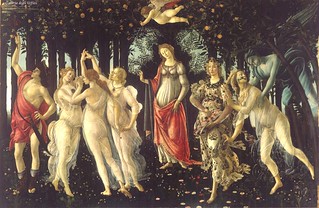
-Sandro Botticelli- Primavera (Spring)
Not only did egg-tempera make painting extremely time-consuming... and thus expensive... but being painted on wood panels... in the days before plywood... made the paintings... especially a large painting like Primavera... quite heavy and difficult to move or transport. The medium also limited the amount of changes a painter might make to a painting. Large scale composition changes were nearly impossible... requiring the surface be sanded down and the new passages be feathered into the old.
Oil painting was developed in the North by Netherlandish painters such as Jan van Eyck:

Jan van Eyck- The Arnolfini Wedding
and Rogier van der Weyden:

Rogier van der Weyden- St. Luke Drawing a Portrait of the Madonna and Child
These Flemish masters had discovered that they could achieve the most brilliant colors and the most subtle modeling of forms by the application of thin, semi-transparent layers of oil paint (known as "glazes") over an under-painting of egg-tempera. Quickly they discovered that egg-tempera could be done away with all together. Art patrons and collectors across Europe were in awe of the phenomenal detail and illusion of real space and form that the Flemish painters could achieve. Naturally, they were quite protective of their techniques.
The development of oil painting in Venice, owes much to fortune. The painter, Antonella da Messina, settled in Venice, bringing with him the knowledge of the new technique.

Antonella da Messina- Portrait of a Young Man

Antonella da Messina- St. George in his Study
There are various notions as to how da Messina acquired a grasp of oil painting, but the best theory is that he learned the technique from Jan van Eyck's pupil, Petrus Christus:

Petrus Christus- Portrait of a Young Lady

Petrus Christus- The Annunciation
As both Antonello and Petrus Christus were in Milan at the same time... and as Antonella left Milan with a grasp of oil painting while Petrus Christus soon after exhibited the first examples of the use of linear perspective in Northern painting (a development then known only to the Italians), there is a strong likelihood that the two artists exchanged "trade secrets".
Settling in Venice, the technique of oil painting spread from da Messina to the leading Venetian painters... including Giovanni Bellini:

Giovanni Bellini- Portrait of a Gentleman

Giovanni Bellini- The Portrait of Doge Leonardo Loredan
The early Italian attempts at oil paint did not vary far from the Flemish models. The primary concern remained cracking. But with time it became apparent that oil paint had a flexibility that avoided this problem. At the same time, Venice was asserting itself as a cultural center... but was unable to compete with the epic fresco paintings of Florentine masters such as Giotto, Fra Angelico, Simone Martini, etc... The humidity and constant flooding of Venice led to the rapid deterioration of attempts at fresco... and painting on an epic scale on wood panels was wholly impractical. Again, fortune came to the aid. Do they not say "Necessity is the Mother of Invention." Venice, as a great naval power, had developed into a leading maker of canvas for sails... made with Flemish linen. At some point it was recognized that the flags on ships and decorations on the sails were essentially paint on canvas, and so the artists began to experiment with oil on canvas... primed with rabbit's skin glue to avoid the deterioration of the linen fibers caused when oil came into contact with the fabric. The artists began timidly... but soon realized that oil paint held up incredibly well... and that they could work in a direct manner... without detailed drawings... immediately on the canvas... making changes as they saw fit.
For much of the later 15th century, the Bellini Family dominated painting in Venice. There was Giovanni Bellini's father, Jacopo Bellini:

Jacopo Bellini- The Annunciation
His brother, Gentile Bellini:

-Gentile Bellini- The Miracle of the Bridge of San Lorenzo
and their Brother-in-Law, Andrea Mantegna:

Andrea Mantegna- The Arrival of the Cardinal Francesco Gonzaga
Giovanni began his career as a talented and poetic painter and was quickly recognized as the leading painter in Venice. He established stylistic conventions that would be followed by later Venetian artists such as his approach to the theme of the Madonna and Child:

Giovanni Bellini- Madonna and Child
And his large altarpiece paintings that are among the first epic-scaled paintings in Venice:

Giovanni Bellini- The Baptism of Christ

Giovanni Bellini- The San Zaccaria Altarpiece

Giovanni Bellini- Detail from the San Zaccaria Altarpiece
These painting began to establish the Venetian tradition of atmospheric painting. Bellini establishes the sfumato ... the softened, smoky edges that suggests the illusion of depth as edges become increasing blurred as the recede in space. This technique will be famously adapted by Leonardo da Vinci in the landscape backgrounds of his paintings:

Leonardo da Vinci- La Gioconda/Mona Lisa; Portrait of Lisa Gherardini, wife of Francesco del Giocondo
But Bellini and the Venetians bring to this technique a brilliance of color... owed to the Flemish painters. This was achieved through layers of semi-transparent "glazes" until that the paintings literally glow like stained glass.
Bellini stands as one of the great artists of art history whose work continued to grow and develop as the artist was open to ideas developed by younger artists. The two most important younger painters in Venice were Giorgio Barbarelli da Castelfranco (or Giorgione) c. 1477/8 – 1510, and Tiziano Vecellio (or Titian) c. 1488/1490 – 27 August 1576. In spite of his short life span and limited oeuvre, Giorgione is one of the most important painters in the history of Western Art. If the greatest loss to music due to an early death was Mozart or Schubert, Giorgione's premature death must be among the greatest losses to the visual arts.
In the ten years, from 1500 until Giorgione's death in 1510, the triumvirate of Bellini, Titian, and Giorgione worked so closely together... physically and stylistically... that it is often difficult to discern who painted what. 500 years later, there remain disputes concerning major paintings.
Giorgione's early works echo elements of Bellini's portraits...

Giorgione- Portrait of a Man

Giorgione- Portrait of a Gentleman

Giorgione- Portrait of Francesco Rovera
Yet by the time of his Portrait of a Gentleman...

Giorgione- Portrait of a Gentleman
... he is already suggesting stylistic elements that will later be employed by Titian...

-Titian- Portrait of a Gentleman in Blue Sleeves
... and eventually Raphael...

Raphael Sanzio d'Urbino- Portrait of Baldasarre Castiglione
and even Rembrandt:

Rembrandt van Rijn- Sketch after Raphael's Portrait of Baldasarre Castiglione

Rembrandt van Rijn- Self Portrait 1659
Giorgione's religious paintings build upon Bellini's use of atmosphere and brilliant color. Some art historians have suggested that these elements owe much to the natural environment of Venice... the humidity as a result of the location of Venice leading to a blurring of edges... and refraction of colors. The effect in person is almost akin to that of stained glass... as the paintings virtually glow.

Giorgione- The Holy Family

Giorgione- Sacrae Conversazion

Giorgione- Sacrae Conversazione

Giorgione- The Virgin and Child in a Landscape

Giorgione- Judith

Giorgione- The Adulteress Brought before Christ

Giorgione- The Madonna and Child Enthroned

Giorgione- The Judgment of Solomon

Giorgione- Moses' Trial by Fire
Whatever the truth may be, few paintings have ever glowed as richly as those of the Venetian School... and it is not surprising that many painters deem the School of Venice... from Bellini through Tintoretto, Veronese, and Tiepolo...
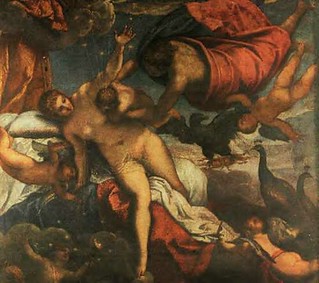
Tintoretto- The Birth of the Milky Way

Veronese- Perseus and Andromedae
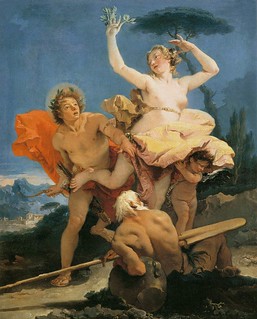
Giovanni Battista Tiepolo- Apollo and Daphne
...as the peak of Western painting. While the art historian, Giorgio Vasari was rather dismissive of the whole Venetian School, this was to be expected. Vasari was himself a painter... deeply schooled in the lessons of the Florentine/Roman School and artists such as Michelangelo and Raphael who stressed line and form... drawing above all else. The Venetian School stressed color and brushwork... and as such they would become the model for all future "painterly" approaches... including Peter Paul Rubens:
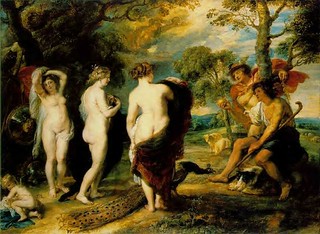
Sir Peter Paul Rubens- The Judgment of Paris
... Rococo painters such as Boucher...

Francois Boucher- Portrait of Mademoiselle O'Murphy
... Romantics such as Delacroix...

Eugene Delacroix- Algerian Women
... the Impressionists...

Pierre Renoir- La Loge
... and beyond:

-Henri Matisse- Zora on the Terrace

Philip Guston- For M.
One of Giorgione's last religious paintings is the magnificent Adoration of the Shepherds.
This is one of those paintings open to dispute as to authorship. There are elements suggestive of Bellini's last paintings, and some suggest it was begun by Bellini. There are also elements that point toward early Titian... and paintings such as Noli me tangere:

Titian- Noli me tangere ("Touch me not...")
Whatever the case may be, the Adoration of the Shepherds is an absolutely stunning painting... and one of my absolute favorites. I never fail to spend a good time with it whenever I visit Washington D.C. and the National Gallery.

Giorgione (Bellini?)- Adoration of the Shepherds
The structure or composition of paintings prior to the Giorgione and the Venetian School tends to be obvious... often based on geometric structures. If we were to make a comparison to literature, we might draw an analogy with formally structured works such as sonnets... or Dante's terza rima. Giorgione and the Venetian School employed a far more organic approach to composition. Again, if we were making a comparison with literature, we might draw a comparison with Wordsworth or Whitman and a far freer structure. Giorgione ties the Adoration of the Shepherds together with a repetition of arches... the cave moth, the bodies of the participants, the shrubs, and even the rocks... but the effect is as if this were all natural... not as if the artist had intentionally composed the work, but rather as if he had merely painted what was before his eyes.
Giorgione's most innovative works are those that some have termed "poesies". These are paintings in which the artist has broken with the expectation that outside of the realm of portraiture (and the genre of landscape has yet to have evolved) the goal of all painting is to illustrate a narrative... from history, from literature, from mythology... or from the Bible. The painter today takes it for granted that he or she may paint whatever comes to mind... whatever interests them. But prior to Giorgione, this was not so.
Looking at a painting such as Nymphs, Children, and Shepherds in a Landscape:

Giorgione- Nymphs, Children, and Shepherds in a Landscape
... we are immediately baffled as to just what the hell the subject is. Ultimately, it is just what it is: nymphs, children, and shepherds lolling about in some bucolic landscape. WE can struggle to uncover some Greco-Roman mythology involving Venus and other goddesses... but there are no elements to suggest such.
Let's look at another of the poesies: the Landscape with Sunset:

Giorgione- Landscape with a Sunset
There are few (if any) true landscapes prior to those of Albrecht Dürer...

Albrecht Dürer- House by the Pond
At a time in which travel was dangerous and the great untamed distances between cities were filled with bears and wolves and highway robbers, nature... and landscape... had not yet been romanticized. And yet... here Giorgione seemingly offers a painting that is first and foremost a landscape. There is a figure rearing on a horse before a serpent... possibly St. George... and there's a couple of men sitting in the foreground... one apparently helping the other with his boot (perhaps he's broken or sprained an ankle)... but the painting is essentially a landscape... one of the first in the genre.
Another painting that has similarly baffled art historians is the so-called "Tempest":
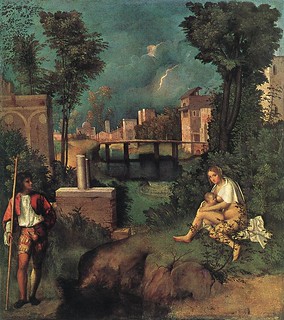
Giorgione- The Tempest
What we are presented with is an image of a nearly nude woman breastfeeding in the forest landscape outside a city. To the left stands a soldier, and the dark clouds and a flash of lighting suggest an on-coming storm... the "tempest" of the title. Some have suggested that the painting represents the flight of the holy family into Egypt... but to present Mary nude would have verged upon heresy. And where is Joseph? Who is the soldier? Where are any symbols that might lead us to recognize that this is indeed an image of the Holy Family? Where painters were expected to illustrate known narratives employing recognized symbols and iconography, Giorgione has essentially invented a narrative of his own... and challenged us to interpret it.
This is as true of his stunning nude, the so-called Dresden Venus:
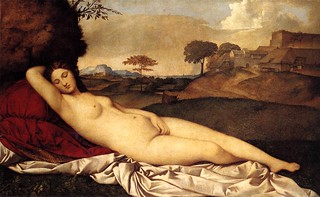
Giorgione- The Dresden Venus
The absolute wealth of female nudes in Western painting has resulted in a failure by many to recognize just how innovative this painting by Giorgione was. Giorgione has essentially invented the genre of the "reclining nude". Where Botticelli's Primavera revived the Greco-Roman tradition of the Three Graces and his Birth of Venus...
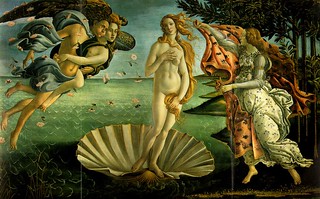
Sandro Botticelli- The Birth of Venus
... revived the tradition of the Greco-Roman standing Venus... especially per the example of the Medici Venus...

Roman after a Greek original: The Medici Venus
Giorgione's Dresden Venus in one fell swoop virtually establishes the tradition of the reclining nude. There were Etruscan and Roman precursors to Giorgione's reclining figure... but these are nearly all clearly portraits... or representations of Venus or other goddesses. But is we look at Giorgione's sleeping nude, there is absolutely nothing that suggests that she is indeed Venus. Giorgione has simply presented us with an image of a beautiful nude woman sleeping in the warm hills outside of Venice. Where art historians often argue that the purpose of painting the nude has some higher, symbolic value... Giorgione offers us a painting in which he has simply painted a beautiful nude woman because he finds her attractive... beautiful. The painterly manner in which she is rendered... the lack of hard contours and sculptural form... and the sensuality of the brushwork, the softened edges, and the warm and atmospheric color stresses the sense of touch.
Subsequent artists would jump on the subject after Giorgione opened the door. Shortly thereafter we get Titian's Venus d'Urbino:
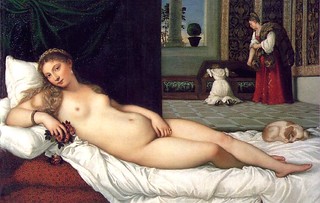
Titian- Venus d'Urbino
and in the 19th century, we get Manet's Olympia:

Edouard Manet- Olympia
Both paintings outraged members of the audience for the simple reason that like Giorgione's audacious painting, they did not disguise the sexual or erotic raison d'etre behind the work.
Giorgione's most famous painting, along with the Dresden Venus, most certainly must be the stunning Fête champêtre:
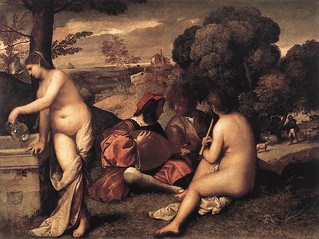
Giorgione (Titian?)- Fête champêtre
This is yet another painting open to dispute with regard to authorship. Some art historians ascribe the painting to Titian... or suggest that it may have been completed by Titian, while others... pointing to the open-ended narrative... attribute the work to Giorgione. This painting again became the source of a work by Manet, Le déjeuner sur l'herbe:

Edouard Manet- Le déjeuner sur l'herbe
Manet was astutely struck by the fact that the Fête champêtre was essentially nothing more than a painting of a couple of fashionable dressed young men accompanied by a couple of naked women sitting about enjoying the landscape on a warm summer's day. Manet recognized that the subject matter of the Fête champêtre... or rather its lack of any legitimate narrative... was diffused by the perfume of time. One of the prize possessions of the Louvre, no one questioned what was really going on in the Fête champêtre... but when Manet ironically modernized the theme matter and set the same subjects in a park in 19th century Paris, the result was outrage.
There have been attempts to assign a narrative to the Fête champêtre. Some have suggested that the manner in which the men seem oblivious to the presence of the nude women as well as the classical robes of the woman on the left implies that the women are actually invisible muses to the pair of musicians. Regardless, Giorgione has again presented us with an open-ended narrative... rather than a clear illustration of a known narrative using accepted symbols and iconography.
I had the chance to see the Fête champêtre in person in the National Gallery, Washington some few years ago. The painting absolutely glows and exudes an unbelievable sense of warmth and atmosphere. It stands among my favorite paintings of all time.
The year before he died, Giorgione completed work on the so-called Three Philosophers:

Giorgione- The Three Philosophers
The work was commissioned by Taddeo Contarini, a Venetian merchant with an interest for occult and alchemy. It was later partially reworked by Sebastiano del Piombo and the painting was cut down... somewhat unbalancing the work. Again, the subject matter of the painting is left open-ended and uncertain. Some have suggested that the three men represent three Greek Philosophers... and there are constant disputes as to just which philosophers. Another intriguing interpretation suggests that the three men represent the three great Abrahamic religions: the bearded figure on the right being Moses (or Abraham), holding the law; the turbaned central figure representing Muhammad, and the young, seated figure being Matthew of Patmos writing down his visions and Revelations. Still other interpretations suggest the three represent the 3 Magi, or the ages of European Civilizations (the Classical Age, the Middle Ages, the Renaissance), or merely the Three Ages of Mankind (Youth, Middle Age, Old Age). The manner in which the young man looks into the darkened void of the cavern is especially intriguing (Matthew... Youth looking into the future?). Again, the painting glows with a sensuality and a warmth that will be valued by generations of subsequent painters.
Beware of the man with just one book. -Ovid
The man who doesn't read good books has no advantage over the man who can't read them.- Mark Twain
My Blog: Of Delicious Recoil
http://stlukesguild.tumblr.com/

Similar Threads
-
By Cliche in forum Personal Poetry
Replies: 0
Last Post: 06-06-2013, 01:36 PM
-
By ANON in forum Silas Marner
Replies: 1
Last Post: 04-17-2013, 06:17 AM
-
By chimney_swift in forum Short Story Sharing
Replies: 0
Last Post: 04-25-2010, 01:56 AM
-
By BjorkPlease in forum General Literature
Replies: 36
Last Post: 03-30-2010, 04:00 AM
-
By kiobe in forum General Chat
Replies: 8
Last Post: 06-16-2007, 02:02 AM
 Posting Permissions
Posting Permissions
- You may not post new threads
- You may not post replies
- You may not post attachments
- You may not edit your posts
-
Forum Rules





























































 Reply With Quote
Reply With Quote